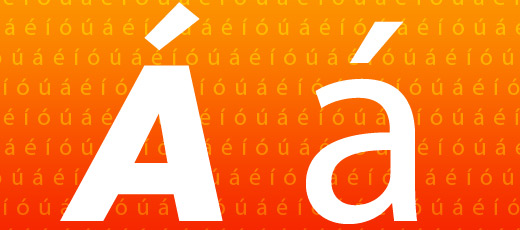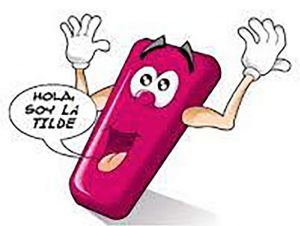
Tildes change the pronunciation, and even the meaning, of Spanish words.
Tildes confuse a fair few Colombians, so it’s no wonder that learners often have a lot of trouble with these little marks. Diana Mejía explains how you can learn to love these insouciant little flicks above vowels.
If we lived in a world of monosyllabic words, there’d be no need to stress syllables. But as soon as two or more syllables come into the picture, a choice must be made: where is the stress? This means pronouncing a syllable a bit louder, longer or with a different tone of voice, and the answer can make a difference in the meaning of the word. Is it PRO-ject or pro-JECT? In Spanish, the syllable where the stress falls is the sílaba tónica, while its unstressed friend is the sílaba atónica.
• Sílaba tónica: es-TA-do, por-TAL, PLÁ-ta-no
In Spanish, all multisyllabic words are stressed, and they can be broadly divided into three categories depending on where the stress falls; palabras agudas, graves, esdrújulas and sobreesdrújulas.
Palabras agudas have the stress on the last syllable
• A-mor, co-ra-zón, pa-red, com-pás, ca-fé
Palabras graves have the stress on the second to last syllable. This is the standard stress pattern is Spanish, so when in doubt you can play it safe and assume this is where the word stress lies.
• Dia-rio, jo-ven, ár-bol, cri-sis, e-xa-men
Palabras esdrújulas have the accent on the third to last syllable, while sobreesdrújulas, the rarest of the bunch, have the accent on the fourth to last.
• Pró-xi-mo, miér-co-les, pá-ja-ro, hé-ro-e, sin-té-ti-co
• Dí-ga-me-lo, no-ti-fí-quen-se-lo, trái-gan-nos-la
So, with that in mind, let’s get into the meat of the issue. How do we decide which words in the same category get accents? Why doesn’t aMOR have a tilde but coraZÓN does, even if they are both agudas? This is one concept that causes a bit of confusion; while all words are stressed, they don’t all have a tilde.
Palabras agudas have a tilde when the word ends in a vowel, or a vowel + n or s.
• Ma-ní, ca-yó, cons-truc-ción, and in-glés take a tilde, but not
• Ho-nor, a-zul, per-so-na-li-dad, or a-yer.
With a few exceptions, palabras graves take a tilde when the word ends in any consonant that’s not an “n” or an “s”. Saying it the other way around, if they finish in an “n” or an “s”, or any vowel, then they don’t take a tilde.
• Ú-til, Ló-pez, ca-rác-ter, and ár-bol take a tilde, but not
• Vir-gen, cri-men, do-sis, cie-lo or sua-ve.
Finally, esdrújulas y sobreesdrújulas, while the term is difficult to pronounce, these are actually the easiest of the bunch. Because they are irregularly stressed words, they must all take a tilde.
• Ré-gi-men, má-qui-na, A-mé-ri-ca, hi-po-pó-ta-mo, Á-gui-la.
 When there are two vowels in a row, things get a little bit complicated. A diptongo is a combination of vowels that is pronounced in the same syllable (bai-la, cie-rra), while in a hiato the vowels are part of separate syllables (ma–es-tro). The former always consists of an open vowel (a, e, o) and a closed vowel (i, u), and the stress of the word goes on the open vowel (bAi-la, ciE-rra) by default. However, if the pronunciation of the word doesn’t reflect this, then we must use a tilde to indicate it. Such is the case in maestría, habría, raíz and tío. On the other hand, hiatos follow the general rules mentioned above.
When there are two vowels in a row, things get a little bit complicated. A diptongo is a combination of vowels that is pronounced in the same syllable (bai-la, cie-rra), while in a hiato the vowels are part of separate syllables (ma–es-tro). The former always consists of an open vowel (a, e, o) and a closed vowel (i, u), and the stress of the word goes on the open vowel (bAi-la, ciE-rra) by default. However, if the pronunciation of the word doesn’t reflect this, then we must use a tilde to indicate it. Such is the case in maestría, habría, raíz and tío. On the other hand, hiatos follow the general rules mentioned above.
As we covered in the beginning, monosyllabic words, by their very nature, don’t require a tilde. However, there are some situations where we are required to use one in order to differentiate them from their homophones. A tilde that serves this purpose is called a tilde diacrítica (see purple section of table).
These tildes also help differentiate between questions, exclamation and affirmative words. Note that the interrogative form (always with a tilde) applies to both direct or indirect questions (see blue section of table).
The same idea applies to quien or quién, cual or cuál, and cuando or cuándo (see orange section of table).
The tilde diacrítica avoids the PRO-ject vs. pro-JECT confusion we have in English, by simply showing where the word stress lies.
• público (public), publico (publish) y publicó (published)
And finally, the one that is actually a lot easier to understand if you’re an English speaker: the difference between porque, porqué, por que and por qué.
Por qué = Why?
• ¿Por qué no quieres ir a la fiesta?
• No comprendo por qué te pones así
Porque = Because
• No fui a la fiesta porque estaba muy cansado
El porqué = Noun: the reason why, the cause or motive for something.
• No comprendo el porqué de tu actitud (I don’t understand the reason for your attitude).
• Todo tiene su porqué (everything has a reason for being).
Por que = For which, so that. It is a combination of the preposition por and the relative pronoun que, and is often used with an article in between them.
• Este es el motivo por (el) que me contrataron (that’s the reason for which I was hired).
Otherwise, it is used as a combination of the preposition por and the subordinate conjunction que. This applies to verbs, nouns and adjectives that have a complement introduced by the word por and in addition, have a subordinate sentence introduced by the word que.
• La obra se caracteriza por que atrae a audiencias de todas las edades.
While this might seem like a lot of information, try to start by identifying the tildes in everyday situations, such as signs, newspapers and menus. As you start to pick up the patterns, it will all come together to transform you into a real tildes buff.
Without a tilde |
With the tilde diacrítica |
||
| de | Preposition: Las llaves de la casa. | dé | From the verb to give (dar): No le dé la clave a nadie. |
| el | Article: El escritorio es nuevo. | él | Personal pronoun: Hablé con él. |
| mas | Conjunction: Quiso ir, mas no lo dejaron. | más | Adverb of quantity: ¿Quieres más? |
| mi | Possessive adjective: Juan es mi mejor amigo. | mí | Personal pronoun: A mí me gusta el teatro. |
| se | Personal pronoun: Se fueron a Europa. | sé | Conjugation of the verbs ser o saber: No sé la respuesta. |
| si | Conditional: Si estudias, te irá bien en el examen. | sí | Affirmation: Sí, soy canadiense. Personal pronoun: Solo habla de sí mismo. |
| te | Personal pronoun: ¿Te gusta la música clásica? | té | Beverage: Me encanta el té. |
| tu | Possessive adjective: Me gusta tu camisa. | tú | Personal pronoun: Tú trabajas demasiado. |
| aun | Adverb (until, also, even): Aun los pequeños lo saben. | aún | Adverb (still): Aún lo estamos esperando. |
| cuanto | El huracán destrozó todo cuanto encuentro a su paso. | cuánto | ¿Cuánto ganas? Me preguntó cuánto dinero ganaba. |
| donde | El apartamento donde viven es muy agradable. | dónde | ¿Dónde fuiste de vacaciones? No sabemos a dónde fue de vacaciones. |
| que | Me dijo que no quería venir. Comió tanto que estuvo toda la tarde con dolor de estómago. |
qué | ¡Qué gran triunfo! ¿Qué comiste hoy? |
| este(as), ese(as), aquel(las) | Are used with an adjective: Este libro, esa mujer. | éste(as), ése(as), aquél(las) | Take the place of the adjective: No quiero ése, quiero éste. |
| esta(s) | Demonstrative adjective: Esta comida. | está(s) | ROVerb conjugation: No está en la oficina. |
| solo* | Adjective: Está viviendo solo. | sólo* | Only: Sólo ella sabe la verdad. |
| Estoy aquí solo para ayudarte (I’m here alone to help you) vs. Estoy aquí sólo para ayudarte (I’m here only to help you). Note that the use of solo vs. sólo is only recommended in situations where there could be confusion as to the meaning of the word. |
|||





